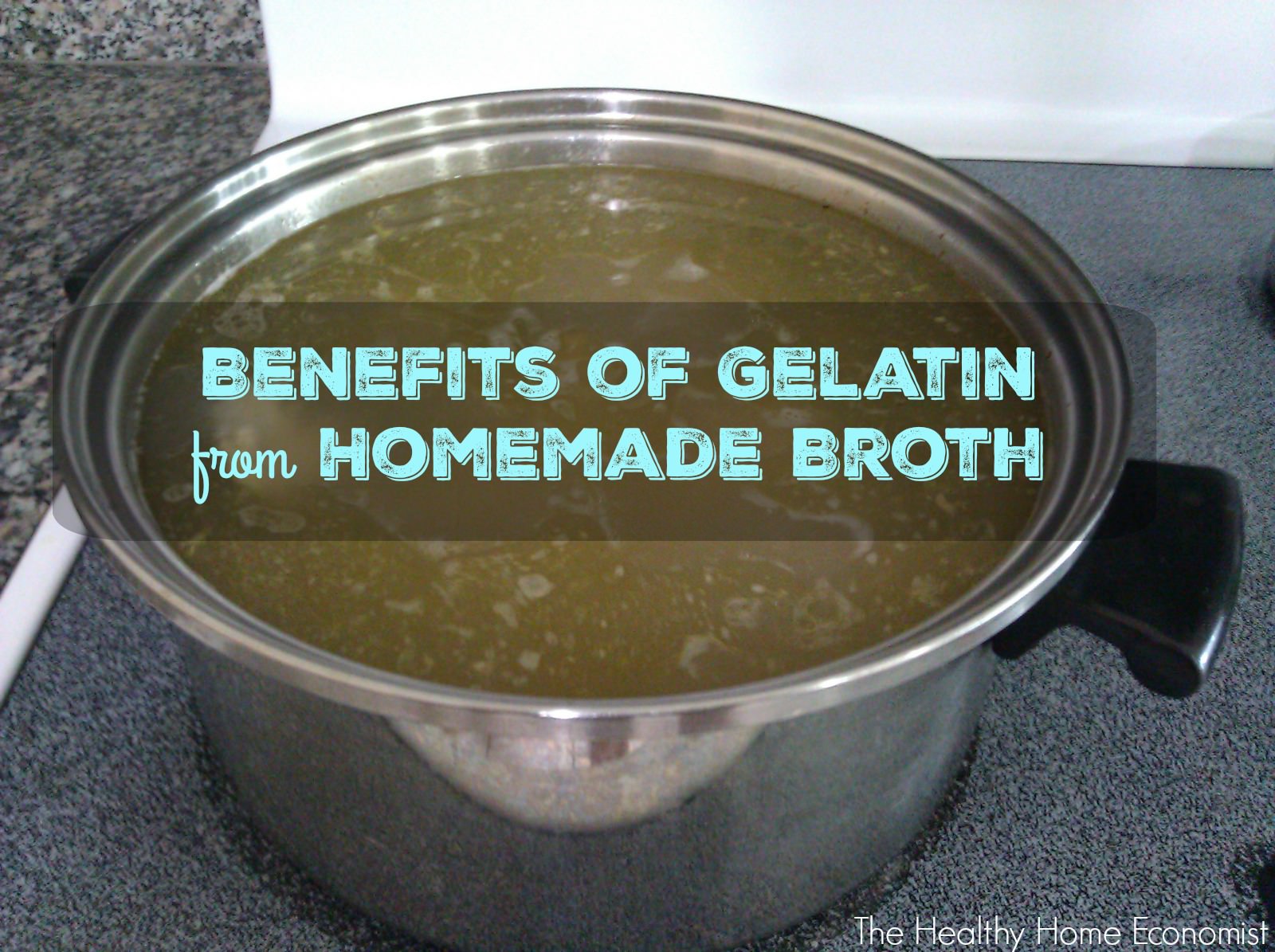Table of Contents[Hide][Show]
 One of the main reasons to learn how to make bone broth as a base for homemade soups and sauces is to supply hydrophilic colloids to the diet. This opens up the door to obtaining the numerous benefits of gelatin to health.
One of the main reasons to learn how to make bone broth as a base for homemade soups and sauces is to supply hydrophilic colloids to the diet. This opens up the door to obtaining the numerous benefits of gelatin to health.
The hydrophilic nature of the gelatin in homemade meat broths has the unusual property of attracting digestive juices to itself. This is in the same manner as raw foods.
There is an extensive amount of research on gelatin benefits in the diet. Gelatin obviously aids digestion by rendering digestive juices more effective by attracting them to itself. It also has been found successful in treating digestive disorders such as IBS, colitis, and even Crohn’s disease.
Anemia and other blood disorders respond in healing fashion to gelatin in the diet. Interestingly, the first known reference to gelatin is from 204 AD. Chinese writings of that time describe gelatin as an agent to arrest bleeding or hemorrhage.
Benefits of Gelatin as a Home Remedy
Homemade stock is indispensable when a stomach flu makes its way around a household. It can slow and stop diarrhea when small amounts are consumed every few minutes.
In addition to stopping the runs, gelatin assists in neutralizing whatever intestinal poison is causing the problem. Unlike anti-diarrhea medicine from the pharmacy which only masks symptoms, gelatin goes to the root of the problem and facilitates healing.
Households where gelatinous broths, soups, and sauces are frequently consumed often get passed by when a stomach bug is making the rounds. Time spent in the kitchen preparing this age old remedy will be repaid many times over with fewer sleepless nights from ill children. No doubt fewer visits to the doctor and ER too.
How to Enjoy More Gelatin Benefits
A frequent question from folks new to Traditional Cooking who are enthusiastically seeking the benefits of gelatin to health, is “how do I get my stock to gel?” What does this mean? A successful batch of homemade bone broth turns into a jelly like substance in the refrigerator. This is due to the gelatin solidifying into a semi-solid state as it cools.
The #1 most common reason for stock that does not gel in the refrigerator is too much water was used to make the stock.
The amount of filtered water should just cover the bones. As the water boils off, feel free to add more water as the stock simmers for the required 4- 24 hours (or up to 72 hours if making beef stock), but only ever add enough additional water to cover the bones.
Stock can always be boiled down on the stove if too much water was inadvertently used. You can even boil it way down to a very concentrated, syrupy, reduction sauce, known as fumee, and then reconstitute with water when you are ready to use it.
Get More Gelatin in Your Stock
Is your stock is already gelling nicely but you want even more gelatin in the final product? Then be sure to ask your local poultry farmer for the heads and feet from your pastured chickens. They add loads of nutritious and healing gelatin to stock.
Another tip is to scald the feet in boiling water to remove the skin before placing them in the stockpot. This will allow even more gelatin to get into your stock.
One final tip is to always start with cold water. Let the bones sit in the water with the bit of vinegar for 30 minutes to an hour before turning on the heat. This allows the fibers of bones and cartilage to open slowly. When this occurs, the maximum amount of flavorful juices and gelatin are released.
Gelatin FAQ
The Reason You Need More Gelatin in Your Diet
Gelatin and Collagen Hydrolysate: What’s the Difference?
Hydrolyzed Collagen Benefits
5 Reasons Your Stock Won’t Gel
Sarah, The Healthy Home Economist
Source: Gelatin in Nutrition and Medicine, Gotthoffer








We have in Hungary and Transylvania a heavy gelatin cold dish -made of pork legs, ears, tongue, skin etc – look at the pics http://www.google.hu/search?q=kocsonya&hl=hu&client=safari&rls=en&prmd=ivns&tbm=isch&tbo=u&source=univ&sa=X&ei=NAtdTt7NG8KF4gS6w6Ex&ved=0CCMQsAQ&biw=1645&bih=796
Add a a “tiny” bit of raw vinegar or reg. vinegar to the stock to help the bones give even more to the broth. I use a pressure cooker and when the bones start turning to powder I remove them and do it again with just the cartilage that is left. It leaves a extremely healthy broth with a unique but highly desirable flavor. You can even drink it as is or add a touch of dark brown sesame oil for the asian flavor.
I also crack the chicken bones with a pair of those fancy pliers (ours are Craftsman Robo Grip) to help bring out the nutritious marrow in the simmering process. And, yes, Maureen, I think you’re right to use a very low burble instead of a real boil which can oxidize the cholesterol, as I understand.
@Tammy, I had this problem as well until I started breaking the bigger bones in half, adding the vinegar, and adding the necks, butts & feet. Heads if I can get ’em. If you are ok with the heart, liver, kidneys, those are great too! But breaking the bones opens more surface area and allows the vinegar easier penetration into the exposed marrow, creating more gelatin. Just my experience, chill it for 12-24 and watch it gel! Good luck!
@Drea…If you roast the beef bones first in a 350 degree oven for an hour or two, you get a much better tasting broth. I also save all my onion peels, pepper tops, carrots peels, basically all veggie scraps, and throw them into the pot as well. (I do that for all kinds of broth.)
Sarah, I also notice that if I actually *boil* the stock, it does not gel well. If I bring it just to a simmer and keep it there for a day or more, it turns out great! I am keeping meat stock on the stove now for everyone to dip into as they wish. It has non-starchy veggies and lentils added for more nutrition, and I am adding bones & scraps as they are available.
Hmm, I pressure cook my bones usually and have no problems with gelling. In fact most of the bones mush when picked up and as long as I don’t use too much water the broth is almost always thick enough to cut with a utensil, like jello.
You may want to research why you shouldn’t pressure cook. Nourishing Traditions says that pressure cooking raises the temperature of foods too much and kills of what’s nourishing in them.
Maureen, I noticed that too. Sometimes I leave the pot simmering on the stove unattended for too long and I come back and it’s boiling away. The resulting stock doesn’t taste as good and doesn’t gel in the fridge.
Question: I’ve been having Chron’s-like symptoms over the past month and have been able to eat only liquid foods like homemade stocks, soups, plain yogurt, etc. I’ve noticed that whenever I eat the broth by itself, it causes my GI tract to almost immediately flare and become very painful. When I eat it in soups, however, it does not do this. Any thoughts on why the plain broth would aggravate my symptoms?
Found you through Holistic Alternative Therapy. Love this post!
I just participated in a cow share so I got the big huge bones from that! I’ve heard I need to prepare that differently than I do my regular chicken broth. What advice do you have?
i keep the fat.. but i almost never get it to gel. i put vinegar in and i use mostly just bones.. hardly any meat.